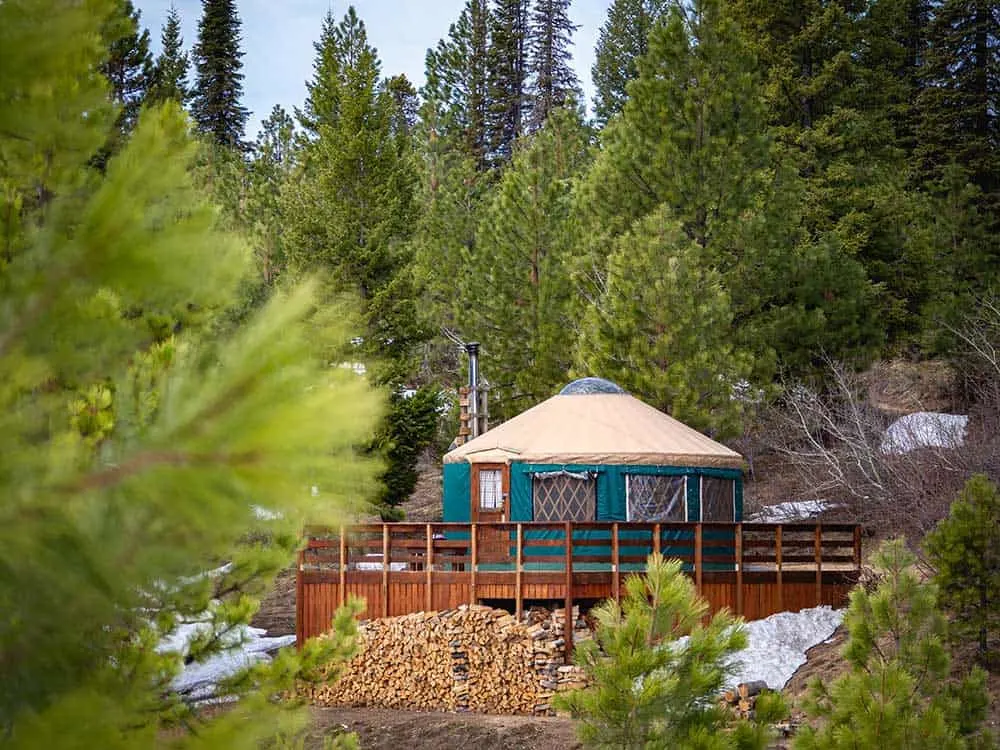Yurts have seen a huge rise in popularity in recent years as people gravitate toward eco-friendly and inexpensive shelters. Off grid yurt living is not a new concept; these lightweight, tent-like structures are modern adaptations of ancient Asian nomad shelters. They are usually built with a circular wood frame, lattice walls, and some sort of fabric cover.
While yurts are traditionally known for their portability, they are more sturdy than tents and we are seeing more and more examples of people using them as a primary residence.
Grace Brogan and John Kamman are two such people. But they certainly aren’t residing in the typical warm and cozy vacation-style setting you might associate with yurt living. They live in their yurt full time in one of the coldest states in the US.
Residing in a yurt may seem like an unusual choice for two employed people with three master’s degrees between them, but for Grace and John, the yurt is a stepping stone toward eventually building an off grid home. It serves as a good learning experience.

Erick / Adobe Stock
John Enger of Minnesota Public Radio News recently traveled to Grace and John’s yurt – a dozen miles north of Bemidji, MN and a half mile hike across a snowy field – to visit the yurt and talk to the couple about their way of life.
The yurt has all the amenities of a small home arranged inside the circular framework, including a kitchen area, a dining table in the center, a bedroom area, a couch, plenty of storage spaces, and a desk.
Both Grace and John work full time from the yurt via high-speed internet, which is their only connection to the grid. They drive into town when they need to, but otherwise have everything they need in their little off grid home.
One thing the home lacks is a bathroom for a toilet and shower, so an outhouse and outdoor sauna serve those purposes. The couple is always mindful of how much water they use since they have to haul it in.
When asked why they chose off grid yurt living, Grace responded, “Eventually we want an off-the-grid house, but the reality of being students for so long, and choosing the careers we’re in, means that ideal is quite a ways off. The yurt is a good way to figure out a small solar panel system and to learn basic construction and be exposed to those things before we’re 50.”
So how do they stay warm in a state where winter temperatures routinely dip well below zero? For one, this yurt is insulated with a material similar to foil-covered bubble wrap along with three layers of canvas. This isn’t enough to keep the coldest temperatures at bay, however, so a little wood stove serves as the heat source for the home.
Diligently keeping the fire going around the clock is the only way to ensure the yurt stays at a comfortable temperature during cold weather. Grace also attributes a huge down blanket to being able to sleep comfortably when the fire gets low.
We didn’t want to go take out a giant mortgage to build a house. We were able to buy this yurt used for $5,000. It’s an option that was super affordable.
Read the full story at MPR News.
Story via Sustainable Simplicity

Leif
Friday 24th of November 2017
Just a suggestion to the couple or anyone else considering a yurt in Minnesota or other cold climates... for heat, consider a rocket mass heater. Their little wood stove is better than nothing of course, but it's hard not to chuckle when reading that they have to tend it diligently! It's not my website, but the forum on (permies.com has lots of info, even on a couple who over wintered in a TEEPEE with an RMH in Montana. (Teepees aren't insulated and have smoke holes up top and ventilation down below, so I'd think a yurt could be positively toasty with much less firewood needed than with a little wood stove!)